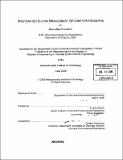| dc.contributor.advisor | E. Eric Adams. | en_US |
| dc.contributor.author | Bhattacharya, Mahua, M. Eng. Massachusetts Institute of Technology. | en_US |
| dc.contributor.other | Massachusetts Institute of Technology. Dept. of Civil and Environmental Engineering. | en_US |
| dc.coverage.spatial | ncho--- | en_US |
| dc.date.accessioned | 2010-01-07T21:01:51Z | |
| dc.date.available | 2010-01-07T21:01:51Z | |
| dc.date.copyright | 2009 | en_US |
| dc.date.issued | 2009 | en_US |
| dc.identifier.uri | http://hdl.handle.net/1721.1/50618 | |
| dc.description | Thesis (M. Eng.)--Massachusetts Institute of Technology, Dept. of Civil and Environmental Engineering, 2009. | en_US |
| dc.description | Includes bibliographical references (leaves 48-50). | en_US |
| dc.description.abstract | Sludge management is a fundamental area of concern across wastewater treatment systems in Honduras. The lack of timely sludge removal has led to declining plant performance in many facilities throughout the country. In addition to maintaining treatment efficiency, proper sludge management is important for mitigating pathogen levels and providing opportunities for safe beneficial reuse of biosolids. Based on analyses of data collected at waste stabilization ponds in the municipalities of Puerto Cortes and La Lima, sludge was characterized with respect to quantities generated (accumulation rates) and quality (helminths and heavy metals content). A review was conducted of appropriate sludge treatment technologies including sludge drying beds, alkaline stabilization, acid stabilization, anaerobic digestion, and composting. These options were evaluated based on a set of selected criteria. Anaerobic digestion, alkaline stabilization, and composting were all found to be suitable methods of sludge treatment. Alkaline stabilization and composting are well suited to facilities with sufficient land. Anaerobic digestion was recommended for areas with land constraints. Treated biosolids can be beneficially used within the community and/or at a regional scale. Potential regional end-uses include soil amendment in agriculture and forestry, or for land reclamation of mined lands. Public participation and acceptance is essential for the success of a biosolids reuse program. Potential strategies for engaging the community and addressing public concerns regarding biosolids were identified. | en_US |
| dc.description.statementofresponsibility | by Mahua Bhattacharya. | en_US |
| dc.format.extent | 78 leaves | en_US |
| dc.language.iso | eng | en_US |
| dc.publisher | Massachusetts Institute of Technology | en_US |
| dc.rights | M.I.T. theses are protected by
copyright. They may be viewed from this source for any purpose, but
reproduction or distribution in any format is prohibited without written
permission. See provided URL for inquiries about permission. | en_US |
| dc.rights.uri | http://dspace.mit.edu/handle/1721.1/7582 | en_US |
| dc.subject | Civil and Environmental Engineering. | en_US |
| dc.title | Wastewater sludge management options for Honduras | en_US |
| dc.type | Thesis | en_US |
| dc.description.degree | M.Eng. | en_US |
| dc.contributor.department | Massachusetts Institute of Technology. Department of Civil and Environmental Engineering | |
| dc.identifier.oclc | 475653507 | en_US |
